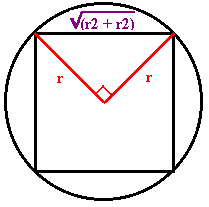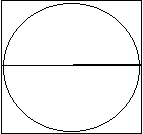Does a square peg fit better into a round hole or does a round peg fit better into a square hole?

Solution
The first step is to define "fits better". This can be connected to the "waste space" after the peg is fitted. This "waste space" is best expressed as a percentage of the larger shape. This is because the answer is then a ratio that is independent of the size of the objects.
Now apply this approach to each situation.

Now if the radius of the circle is r, then by Pythagoras’ Theorem, the side of the square is √(r2 + r2) = √ (2r2) = r √2.
Hence the area of the square is r √2 x r √2 = √ (2r2) x √ (2r2) = 2r2.
And the area of the circle is πr2.
Next we look at the ratio area square/area circle = 2r2/πr2 = 2/π.
As a percentage this is 200/π which is approximately 63.66% so a square peg fills 63.66% of a round hole.

The area of the circle is πr2.
From the diagram, the side length of the square is 2r.
Hence the area of the square is (2r)2 = 4r2.
The ratio area circle/area square = πr2/4r2 = p/4. As a percentage this is 100π/4 = 78.54%, so a round peg fills 78.54% of a square hole.
The circle covers more of the square than the square does of the circle. It is therefore better to be a round peg in a square hole than a square peg in a round hole.